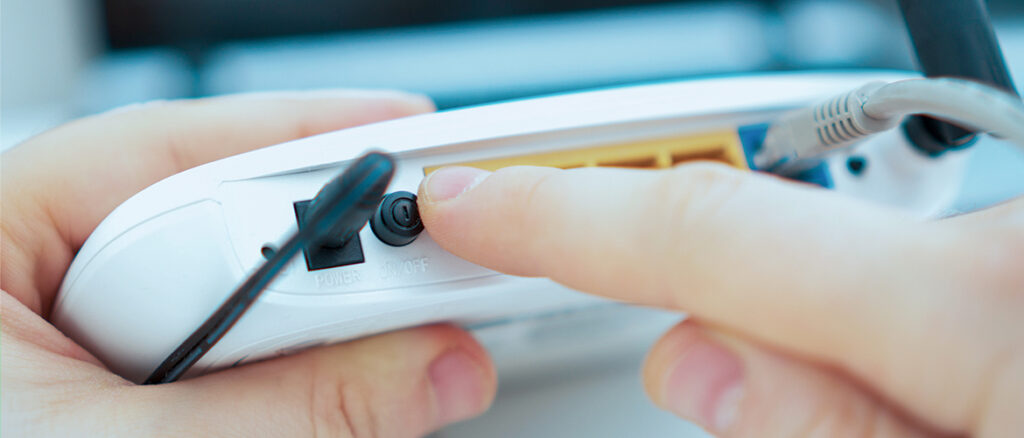
Slow internet has a way of bringing out the feral human in each of us. If you’ve had a few recent bouts of click-rage and you’re ready to trash your router, wait! There’s a reason your internet’s running slow—and we can help you figure it out. Try these six troubleshooting steps to fix common causes of slow internet.
- Close bandwidth-sucking background apps
- Rule out problem devices
- Rethink your VPN
- Troubleshoot your wireless router
- Investigate your ISP
- Upgrade to a better plan
1. Close Bandwidth-Sucking Background Apps
To troubleshoot a slow internet connection, a great first step is closing mobile apps, desktop apps, and web browser tabs and windows you’re not using. Background apps repeatedly ping the internet for updates (some more than others), and those requests stack up.
If that doesn’t boost your speed, the slow connection might be faulty coding or server problems with the one app or website you’re trying to use. Test that theory by closing the app, then quickly opening and gauging the speed on a few other apps or websites. If they run fine, you’ve found the culprit.
You can try a few things to speed up a slow app: sign in and out, uninstall and reinstall, and reboot your device. If the problem continues, submit a help request to the app developer or switch to a better app.

2. Rule Out Problem Devices
Just like you tested apps to isolate the problem, test different devices. If your TV glitches one too many times during a cringey Michael Scott moment on The Office, it could be a problem with your streaming box or cable receiver and not your whole internet connection. Swipe through a couple phone apps and refresh your email on desktop to see if those connections seem normal.
If your streaming box is still the only device lagging, focus your troubleshooting tactics there instead. You could try restarting it, letting it cool if it overheated, or looking up specific connectivity questions on manufacturer or user forums.
3. Rethink Your VPN
Good news—if you don’t know what this means, it’s probably not the reason your internet is slow! Skip to number four.
Unfortunately, virtual private networks (VPNs) slow down internet speed by default. They encrypt your data and send it over different servers and IP addresses from the ones assigned by your internet service provider (ISP). Since encryption and network masking add a tech stack to your internet traffic, that means more time between your data requests and their answers.
If you use a personal VPN, try boosting your slow internet connection by overriding the auto-selected server and choosing one with lower latency. If all connections are lagging, you may not get your preferred speed until you turn the VPN off.
If you use your company VPN for work and it slows your internet connection, ask your boss if you can use it more selectively. With help from the IT department, you could run certain programs locally and use the VPN for more sensitive tasks only.
4. Troubleshoot Your Wireless Router

Routers and modems direct all internet traffic in and out of your home, so their condition can definitely impact your internet connection. Try these tactics to clear the way for faster speeds.
Reboot
Give this well-worn strategy a shot, and you may finish troubleshooting a lot faster.
Check for Software Updates
Most Wi-Fi routers and modem-and-router combos update automatically so their protocols receive traffic from your internet service provider as efficiently as possible. Sign in to your router online to double check that you have auto-updates turned on.
Cable modem settings aren’t quite as accessible as router settings. If there’s a problem with your modem, you probably won’t know until you contact your internet service provider for advanced troubleshooting.
Banish Lurkers
Sign in to your router and make sure you’ve disabled public Wi-Fi. Private networks are more secure and lower your competition for bandwidth.
If you already password-protect your Wi-Fi network, neighbors or visitors who once used your Wi-Fi with permission could still leech off the signal, so check for wireless devices you don’t recognize. Kick them off the island to get some internet bandwidth back. (Also: change your password.)
Optimize Signal
While signed in to your router, check your Wi-Fi settings and enable 2.4 and 5 GHz wireless networks. Dual-band Wi-Fi connections improve speed throughout the house—5 GHz waves run strongly at close range, while 2.4 GHz waves travel better through walls.
As for positioning, Wi-Fi signal works like an umbrella, so the higher up you place your router, the better. If you have obvious signal dead spots in certain rooms, try adding Wi-Fi extenders.
Hardwire an Ethernet Connection
Wi-Fi speeds lag behind wired connections by a few milliseconds. When you need every millisecond you can get, plug your computer right into the router with an Ethernet cable.
Upgrade Your Hardware
Software updates don’t fix everything. When new internet developments come out, for example dual-band wireless connections and fiber speeds, modems and routers built for older services can’t always keep up. Your internet service provider can help diagnose a router problem.
PC World says aging routers can create a slower internet connection after 4–5 years. If you rent or buy yours directly from your internet service provider, you can worry less about when to replace it, since the company will probably advertise new router changes early.
5. Investigate Your ISP
If steps 1 through 4 don’t speed up your slow-running internet, the problem may lie with your internet service provider.
Before you reach out to your service provider, use the HighSpeedInternet.com speed test to see if you’re getting your advertised speeds. A speed test measures the rate of data coming and going from your modem in real time. So if you’re paying for fast internet and still getting slow download speeds and glacial upload speeds, a speed test will clearly show that.
If your test results are much lower than the speeds promised on your contract or bill, call your internet service provider to sort it out. They usually send a reset signal to try and resolve the issue.
If your test results are similar to the speeds you bought, or if your internet provider resets the connection and you’re still unsatisfied with your internet connection speed, it might be time to upgrade your plan.
Note: At the time of writing this article, the COVID-19 epidemic is still underway, causing mass demand on home internet connections. If you reach out to your provider, prepare yourself to hear, “This is the best you can get for now on the plan you have.”
6. Upgrade to a Better Plan
If you’ve done all the aforementioned troubleshooting steps and still have a slow internet connection, you may not have the right plan.
What’s a good download speed?
The Federal Communications Commission says advanced download speeds run at 25 Mbps or more, while medium speeds run from 12 to 25 Mbps and basic speeds run from 3 to 8 Mbps. Anything below that isn’t considered high-speed internet.
A “good” download speed for your home, though, depends on your family’s internet habits. As a rule, your speed needs increase the more audio, HD video, and interactivity (e.g. FaceTime, MMO gaming) your activities use, and the more people connect at once.
For more insights into choosing a plan speed, read our article, What Is a Good Internet Speed?
So. Why Is My Internet So Slow?
Your slow internet connection might be caused by apps, device problems, VPN or Wi-Fi latency, router issues, or just not having a fast enough plan in the first place. If none of those, the cause could be on your internet provider’s end.
Now you have the tools to figure things out. Believe in yourself. We do!

